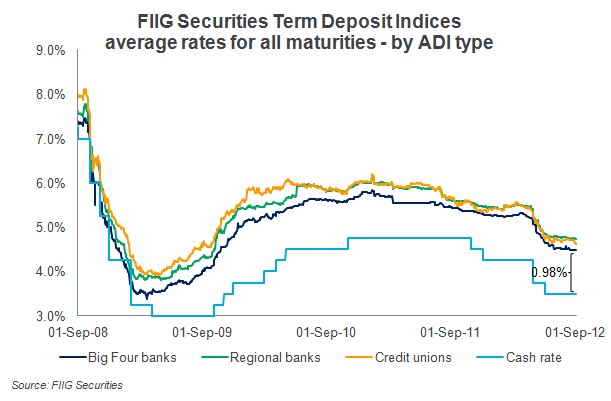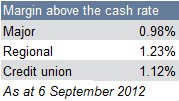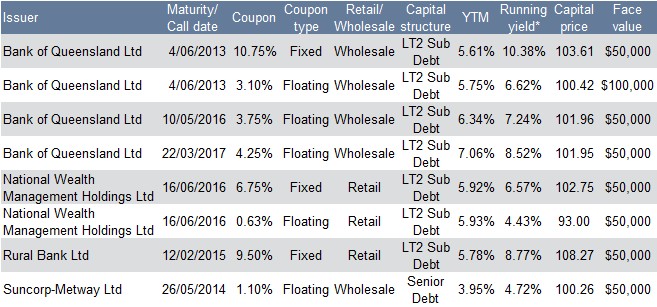by
Elizabeth Moran | Sep 12, 2012
Term deposit rates on offer continue to decline and it seems that scary 4% headline rate is starting to make an appearance.
I’m still very much of the opinion that we’re in for a period of sustained low growth. While GDP figures were higher than expected, there’s little else that gives me any sense that growth will return any time soon and that the RBA will start to increase the cash rate to put a break on the economy. Meaning I expect low term deposit rates to feature for the next 18 months to two years and probably for longer than that. In Australia, mining companies are delaying major projects, China has moderated growth expectations, speculation about quantitative easing 3 in the US continues and I think Europe has decades of low or negative growth ahead even though there’s going to be plenty of liquidity with Mario Draghi’s latest rescue measures. In their statement last week, the RBA board stated:
“Having picked up in the early months of 2012, growth in the world economy has since softened. Current assessments are that global GDP will grow at no more than average pace in 2012, with risks to the outlook still on the downside. Economic activity in Europe is contracting, while growth in the United States is only modest. Growth in China remained reasonably robust in the first half of this year, albeit well below the exceptional pace seen in recent years. Some recent indicators have been weaker, which has added to uncertainty about near-term growth. Around Asia generally, growth is being dampened by the more moderate Chinese expansion and the weakness in Europe”
Essentially I think term deposit investors should be prepared for low rates for longer. If you’re reliant on term deposit income to live, I think now more than ever you should be investigating low risk alternatives and while bond spreads (thus returns) are also moving lower, they still offer an attractive premium to term deposits.
Figure 1 below shows that the average term deposit rates over all maturities for the three sectors (major banks, regional banks and credit unions) have contracted when compared to the RBA cash rate. Since 2012 all average rates have converged with little difference between the three sectors, perhaps an indication of the higher level of deposits at the credit unions, lower lending rates generally and thus a lower need for the cash (see Table 1). What’s also interesting is the margin above the cash rate. At times, it has averaged around 1.50% for the major banks, but is now 0.98%. Currently the regional banks offer the best rates with a 0.25% premium over the majors and if you’ve got less than the $250,000 government guarantee in term deposits, I’d be opting for the best rate and investing in the regionals. Remember than you can always split funds between institutions to make the most of the guarantee.

Figure 1

Source: FIIG Securities
Table 1
The cheaper the cost of funds the better for financial institutions and as investors have sought cash as a safe haven the lower margin would partially reflect higher demand. I guess the worry is that if there’s not as much competition for deposits, there’s no reason that the margin over the cash rate couldn’t contract further.
Table 2 shows the best rates available for each of the three sectors for less than one year and more than a year. All three best rates for less than a year show there’s little difference between them and the major bank rate is well-under 5%. The regional bank offering is over 0.32% better than the major bank one at 5.02%, while the other ADI category needs a minimum $500,000 to get the 4.95% rate. Longer term best rates are slightly better but need higher minimum amounts.

Table 2
Robert Gottleibson in his recent article “The EU rescue and your portfolio” suggested locking in to longer term deposits to get the best rates. This would be an appropriate strategy if you are sure you won’t need to access those funds for five years, but that’s a long time and the annual interest payments wouldn’t be attractive for many investors nor would the break fee if you unexpectedly need to access those funds.
Bonds are the answer. They can increase returns, while taking on a little extra risk yet they are tradeable and will pay coupons (interest) either quarterly or semi-annually. Investors can still expect to receive $100 face value per bond back at maturity. So there’s no need to watch the term deposit or the equity market, you can purchase them and relax.
Table 3 shows some attractive current domestic bank bonds available. We move down the capital structure into subordinated debt to achieve better returns. Bank of Queensland has a range of bonds on issue and while it’s a higher risk investment than a major Australian bank, the bonds are lower risk than the shares. These bonds are structured as 10 year to maturity bonds with a first call at five years. That means we expect the bonds to be repaid at the first opportunity in five years but if for any reason they are not repaid the final legal maturity is 10 years from issue. Some of the longer-dated issues do not have a step-up in the coupon as additional incentive to call, but we take comfort from the fact that no Australian bank has failed to call at the first opportunity. Also, Bank of Queensland successfully had a rights issue earlier this year raising $450m that greatly improved its capital ratios and the buffer supporting bondholders and recently sold three of its large impaired loans to Goldman Sachs, reducing risk on its balance sheet.

Table 3
Yield to maturity is the column to watch. It shows your expected return if you hold the bonds until they are called/ mature. Two longer dated Bank of Queensland subordinated bonds show the best returns. Forecast yield to maturity is 7.06% to first call in March 2017 while the shorter dated May 2016 yields 6.34%. The minimum investment is around $50,000 but these bonds are only available to wholesale investors.
National Wealth Management, a subsidiary of National Australia Bank, is an attractive alternative to term deposits for retail investors. The fixed rate bond has a first call in June 2016 and a yield to maturity of almost 6%, far higher than any term deposit rate.
So, if you’re like the majority of investors that have fled to hold mostly cash, the outlook and the prospect of low term deposit rates will be a concern. Allocating part of your portfolio to bonds will help reduce the impact of low rates.